Research Reports

Trauma and Loss During Reentry
Published:
| Author: Carrie Pettus-Davis, Tanya Renn, Stephanie Kennedy
This report presents data about the extremely stressful life events experienced by study participants in the 8 months after they left incarceration and returned home. These stressful life events included losing a loved one to homicide, having been violently assaulted, witnessing violence and death in the home or community, finding out about the death or serious injury of a loved one, being diagnosed with a life-threatening illness, and losing critical resources like housing, employment, income, transportation, and social support.
Click Here to access the One Page Summary from our Seventh Quarterly Report.
Category: Reentry, Well-Being, 5-Key Model for Reentry
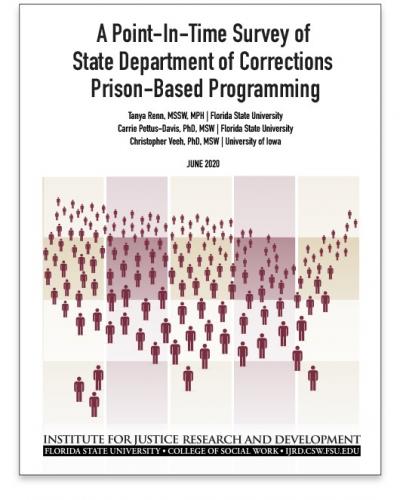
A Point-In-Time Survey of State Department of Corrections Prison-based Programming
Published:
| Author: Tanya Renn, Carrie Pettus-Davis, Christopher Veeh
Research indicates that providing services to incarcerated individuals increases the chance that they will be successful upon reentry to communities. The current study assessed the provision of services (i.e. trauma and reentry) in state departments of corrections (DOCs) throughout the United States. DOCs from all fifty states and the District of Columbia were contacted to determine what services were provided to prisoners, with 44 of 51 providing responses. Results suggest that DOCs provide a range of programming, as well as assessments. Future research should explore the quality and effectiveness of programming and the capacity of existing efforts to meet the growing numbers of people releasing from prison.
Category: In-Prison Intervention

Reforms of Policy Barriers to Positive & Productive Community Engagement of Individuals with Felony Histories
Published:
| Author: Carrie Pettus-Davis, Christopher Veeh, Sheree Hickman
Over the past four decades, civil disability policies have proliferated throughout the United States in tandem with the rising use of criminal sanction as social policy. There are currently more than 45,000 different state and federal statutes that impose a type of civil disability on individuals with a felony conviction. This preliminary report provides a brief overview of the reform efforts that have thus far been enacted, but not introduced, to either eliminate or ameliorate existing civil disability policies at the state level between 2010 and 2017. The first section of the report includes a state-level analysis of the reforms. Next, the second section takes an aggregate view of the reform efforts organized by United States Census regions and divisions. Lastly, an overall review of reform types is presented to identify those reforms with either high or low momentum.
Category: Civil Disabilities

Going Back to Jail Without Committing a Crime
Published:
| Author: Carrie Pettus-Davis, Stephanie Kennedy
This report presents data on reasons other than criminal behavior that 5-Key Model study participants report they were re-arrested.
These technical violations – or violations of the conditions of probation or parole supervision after an individual is released from incarceration – significantly contribute to recidivism across the United States and bring hundreds of thousands of people back to jail every year. The circumstances of re-arrest for those who had not engaged in crime are examined and readers are asked to think about whether current policy and practices are meeting the stated purpose and goals of probation and parole.
Click Here to access the One Page Summary from our Sixth Quarterly Report.
Category: Reentry, Well-Being, 5-Key Model for Reentry

Employment and Behavioral Health-5-Key Model Preliminary Results for Policy Stakeholders
Published:
| Author: Carrie Pettus-Davis, Tanya Renn, Christopher Veeh
This report features preliminary 5-Key Model results on study participant employment and behavioral health outcomes approximately eight months post-release. Results are presented by state to maximize usefulness to policy stakeholders.
Category: 5-Key Model for Reentry, Results for Policymakers

When Death Follows Release
Published:
| Author: Carrie Pettus-Davis, Stephanie Kennedy
This report highlights the reentry period - leaving incarceration and returning home - as the highest risk time for death in a formerly incarcerated individuals’ life. The purpose of this report is to explore the deaths that occur during the reentry period from several different vantage points.
First, what is known about the risk and causes of death for formerly incarcerated individuals from scholarly literature is detailed. Then, the 11 study participants who died in the community after their release from incarceration are described. Finally, composite cases of 6 individuals are presented. These composite cases represent typical life experiences of individuals who die soon after leaving prison.
Click Here to access the One Page Summary from our Fifth Quarterly Report.
Category: Reentry, Well-Being, 5-Key Model for Reentry
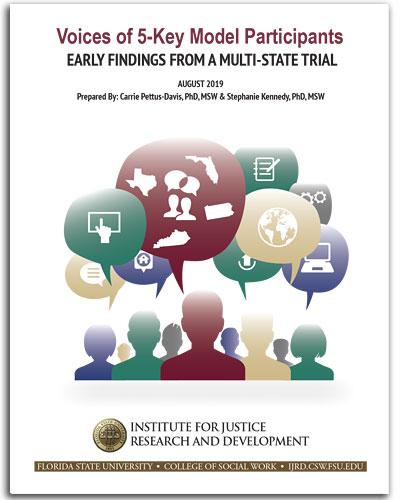
Voices of 5-Key Model Participants
Published:
| Author: Carrie Pettus-Davis, Stephanie Kennedy
This report contains interviews from four study participants involved in the 5-Key Model. The purpose of this report is to highlight the stories of participants in the 5-Key Model to provide a personal window into the experiences of those recently released from prisons. The interview explored participants’ lives and families, successes and challenges, and solicited advice for effectively helping individuals leaving incarceration.
Click Here to access the One Page Summary from our Fourth Quarterly Report.
Category: Reentry, Well-Being, 5-Key Model for Reentry

Accelerating Science Using the Research-to-Practice Feedback Loop
Published:
| Author: Carrie Pettus-Davis, Stephanie Kennedy
The report details the implementation of a Research-to-Practice Feedback Loop and how this Feedback Loop has been used to overcome challenges and adapt both the 5-Key Model intervention and how the intervention is delivered to individuals as they release from prison. The Feedback Loop provides space for practitioners, study participants, and researchers to identify areas for improvement and formalizes a process to ensure that any changes made are consistent with the original model, acceptable to all parties, and implemented fairly across all study sites.
Click Here to access the One Page Summary from our Third Quarterly Report.
Category: Reentry, Well-Being, 5-Key Model for Reentry
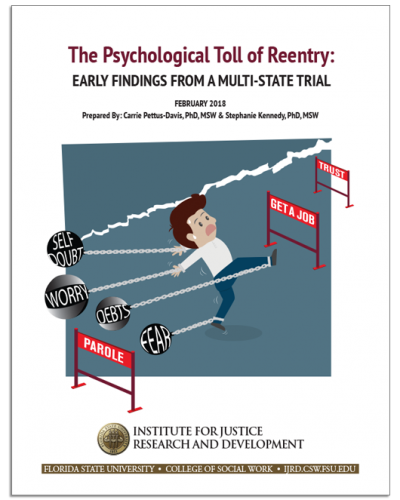
The Psychological Toll of Reentry
Published:
| Author: Carrie Pettus-Davis, Stephanie Kennedy
The struggle of reentry is common across hundreds of study participants and the reentry experience has a wide range of ripple out consequences for individual, family, and community well-being, and it intersects with the potential for future criminal behavior and public safety. This report details the psychological turmoil many individuals experience after release from incarceration, details the impact of reentry on an individual's family, and suggests ways in which men and women may experience reentry difficulty. The report closes by inviting readers and stakeholders to join us in grappling with four intractable realities of the reentry experience.
Click Here to access the One Page Summary from our Second Quarterly Report.
Category: Reentry, Well-Being, 5-Key Model for Reentry
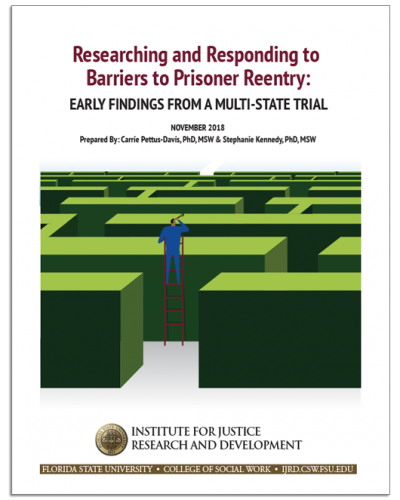
Researching and Responding to Barriers to Prisoner Reentry
Published:
| Author: Carrie Pettus-Davis, Stephanie Kennedy
This report describes the inner workings and early discoveries of participants and researchers in a groundbreaking longitudinal study currently occurring in four states, 50 prisons, 12 urban and rural counties with more than 1800 people enrolled since May 2018. The study, officially titled A Multisite Randomized Controlled Trial of the 5 Key Model for Reentry, is research that is occurring as a part of a larger initiative referred to as the Safe Streets and Second Chances initiative. This report is the first of many that invites stakeholders and the general public to watch the experiment unfold in real time – representing a revolutionary approach to research and evidence driven reentry reform.
Click Here to access the One Page Summary from our First Quarterly Report.
Category: Reentry, Well-Being, 5-Key Model for Reentry

REVERSE CIVIC AND LEGAL EXCLUSIONS FOR PERSONS WITH CRIMINAL CHARGES AND CONVICTIONS
Published:
| Author: Carrie Pettus-Davis, Matthew Epperson, Annie Grier
Civil disability policies entangle persons with criminal convictions in a web of civic and legal exclusions
that revoke or restrict their rights and limit access to services needed for an individual’s successful
community reintegration. These policies—also known as collateral consequences—extend the reach of
criminal justice punishment long after contact with the formal system has ended. There are now an
estimated 40,000 civil disability policies nationwide—policies that affect the daily lives of individuals,
touching every aspect from housing and family composition to education and employment opportunities.
Just as racial, economic, and behavioral-health disparities exist within the formal criminal justice system,
so also the disproportionately negative effects of justice-system involvement play out in the lives and
communities devastated by mass incarceration.
Category: Collateral Consequences of Incarceration, Smart Decarceration
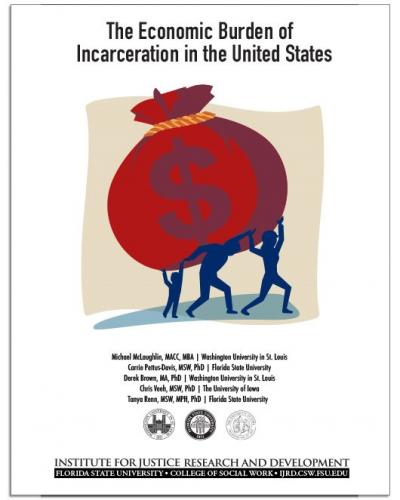
THE ECONOMIC BURDEN OF INCARCERATION IN THE U.S.
Published:
| Author: Michael McLaughlin, Carrie Pettus-Davis, Derek Brown, Christopher Veeh, Tanya Renn
This study estimates the annual economic burden of incarceration in the US. The $80 billion spent annually on corrections is frequently cited as the cost of incarceration, but this figure ignores important social costs including costs to incarcerated persons, families, children, and communities. This study draws on a burgeoning area of scholarship to assign monetary values to 23 different costs, which yield an aggregate burden of $1 Trillion. This approaches 6% of gross domestic product and dwarfs the amount spent on corrections. For every dollar in corrections costs, incarceration generates an additional $10 in social costs, more than half of which are borne by families, children, and community members who have committed no crime. Even if one were to exclude the cost of jail, the aggregate burden of incarceration would still exceed $500 billion annually.

